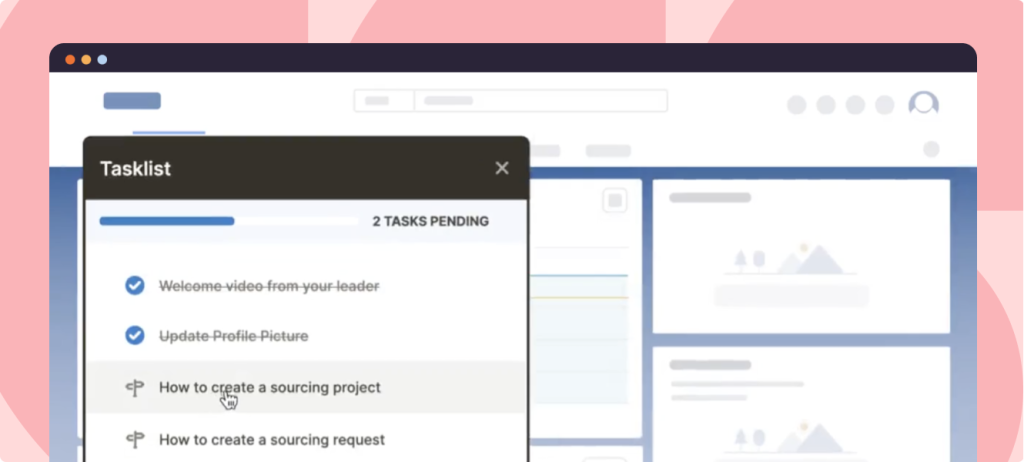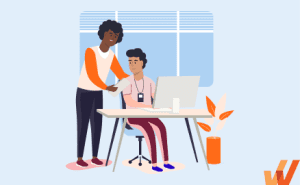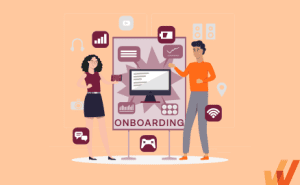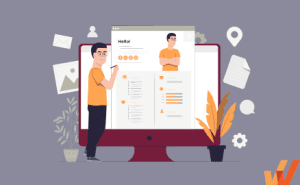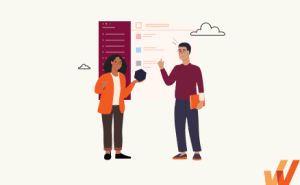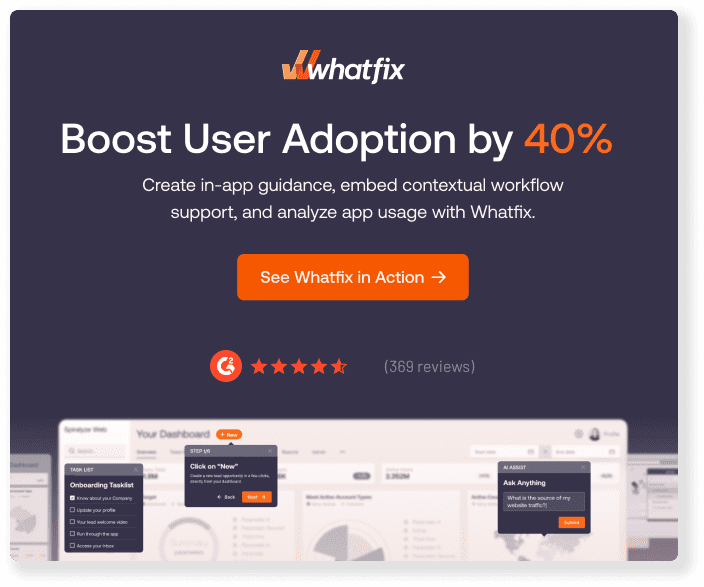A new hire walks into their first day, filled with excitement and a little uncertainty. They’re eager to meet their team, understand their role, and contribute to the company’s success. But what happens next can shape their entire experience. Do they receive a warm welcome, a structured onboarding plan, and the tools they need to thrive? Or are they lost in paperwork, unclear expectations, and minimal guidance?
The onboarding experience defines an employee’s perception of their new workplace—and its impact is undeniable. According to Paychex, 70% of employees believe onboarding can make or break a new hire’s experience.
For HR leaders, onboarding isn’t just a checklist—it’s an opportunity to reinforce company culture, set clear expectations, and build long-term loyalty from day one. The real question is: Is your onboarding process doing enough to engage, educate, and retain new hires?
This guide explores why organizations must invest in a structured onboarding process and how HR leaders can create an experience that fosters employee growth, engagement, and long-term retention. Whether revamping an existing process or building one from scratch, this article will provide actionable insights to help you optimize onboarding for lasting success.
What Is the Employee Onboarding Process?
Employee onboarding is a structured process that transforms new hires into high-performing employees. It starts the moment they sign their offer letter and includes introducing them to company culture, equipping them with essential tools, providing role-based training, and fostering team connections.
A well-designed onboarding experience empowers employees with the knowledge, resources, and support they need to feel confident and productive, driving engagement and long-term success.
Employee Onboarding vs. Employee Orientation
While both onboarding and orientation are essential for new hires, they serve different purposes.
- Employee orientation is a one-time event focused on introducing new employees to company policies, administrative tasks, and workplace logistics. It typically lasts a few hours or a day and is led by HR to ensure compliance and provide essential company information.
- Employee onboarding, on the other hand, is a comprehensive, long-term process that goes beyond basic introductions. It involves role-specific training, mentorship, goal-setting, and cultural integration. Onboarding can last anywhere from 30 to 90 days—or even up to a year—ensuring new employees feel engaged, supported, and prepared to succeed in their roles.
While orientation is a necessary first step, a well-structured onboarding process ensures that new hires become productive, confident, and fully integrated members of the organization.
Key Stages Of the Employee Onboarding Process
Here are the key stages involved in the employee onboarding process.
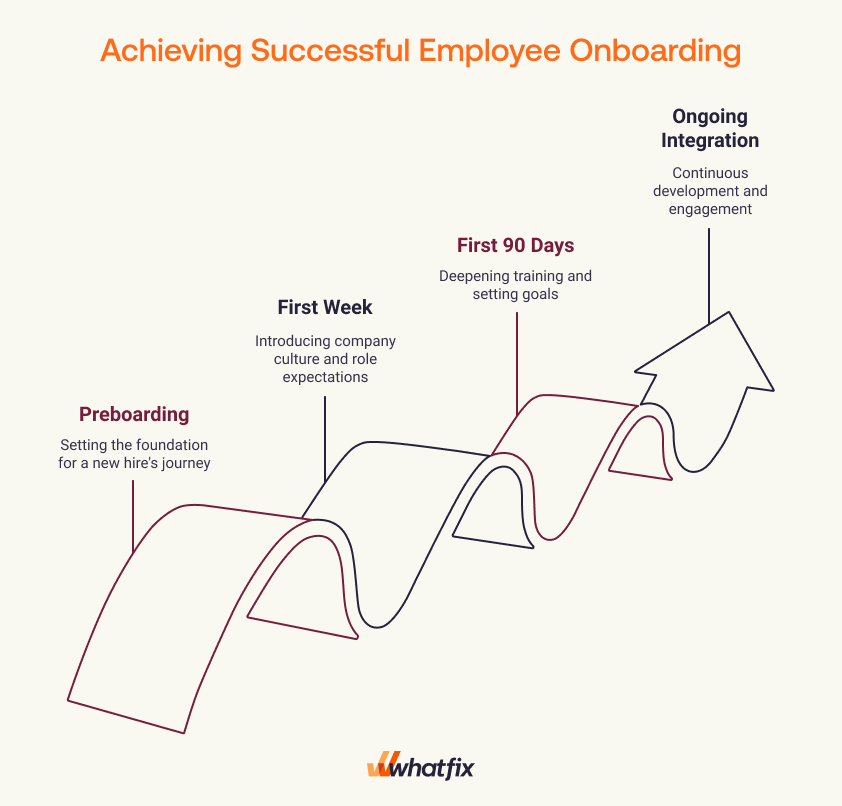
Preboarding
Preboarding begins the moment a candidate accepts their job offer. This stage sets the foundation for a smooth first day by handling administrative tasks such as onboarding documents, IT setup, and providing key company information. It also presents an opportunity to build excitement and engagement by introducing the new hire to their team, sharing company values, and outlining what they can expect in their first few weeks.
First Week
The first week is critical in shaping an employee’s experience and confidence in their new role. This stage includes company introductions, role-specific training, and setting clear expectations. New hires meet their team members, familiarize themselves with workplace tools, and begin understanding their responsibilities. A structured first-week experience helps reduce uncertainty and allows employees to start contributing meaningfully early on.
First 90 Days
The first 30-60-90 days focus on deepening role-specific training, fostering collaboration, and setting measurable goals. This period is when new hires transition from learning to actively contributing. Managers are key in guiding employees through performance expectations, tracking progress, and providing regular feedback. A successful onboarding process at this stage strengthens engagement, builds confidence, and ensures employees feel aligned with company objectives.
Ongoing Integration
Ongoing integration extends beyond the initial three months and ensures that new employees continue to develop, grow, and feel connected to the organization. This stage includes ongoing learning opportunities, career development discussions, and performance evaluations. Employees are encouraged to expand their skills, take on more responsibilities, and participate in company initiatives.
How Long Should Employee Onboarding Take?
Employee onboarding isn’t just a one-time event. It’s a continuous process that ensures new hires feel confident, supported, and fully integrated into their roles. While many companies wrap up onboarding within a few weeks, research suggests that longer onboarding cycles lead to higher employee success and retention rates.
A study by CareerBuilder found that 72% of companies onboard new hires for less than a month, with 51% completing onboarding in a week or less. However, organizations that extend onboarding over 90 days to a full year experience better knowledge retention, engagement, and long-term performance.
Why a Longer Onboarding Process Works Best
A structured, long-term onboarding approach offers several key advantages:
- More comprehensive training: Employees need time to understand company processes, absorb product knowledge, and develop the skills required for their role without feeling pressured to perform immediately.
- Better learning retention: Studies show that new hires retain only 10% of what they learned during onboarding without reinforcement. Extending onboarding ensures ongoing training, mentorship, and hands-on learning to solidify knowledge.
- Stronger employee retention: Workology reports that within the first six months of a new job 86% of employees decide whether they’ll stay or go. A structured onboarding program provides role clarity, continuous feedback, and long-term career vision, reducing early turnover.
- Promotes continuous learning: A longer onboarding period integrates on-the-job training, upskilling, and reskilling initiatives, fostering a culture of continuous development.
9 Steps for Creating a Great Employee Onboarding Process
A well-structured employee onboarding process ensures new hires feel welcomed, supported, and equipped to succeed. Effective onboarding not only improves employee engagement and productivity but also increases retention rates and fosters a positive workplace culture. Below are the nine essential steps to building a successful onboarding process for your organization.
Preboarding
Onboarding begins before the first day. Preboarding is a crucial step that helps eliminate first-day jitters and ensures that new hires feel prepared and excited to join the company. It involves handling administrative tasks in advance, providing essential company information, and making the employee feel welcomed.
Key preboarding activities include:
- Sending a new hire welcome email with key details, including their schedule, team introductions, and company handbook.
- Completing onboarding documents and HR formalities (contracts, benefits enrollment, tax forms, compliance documentation).
- Setting up IT access by providing logins, company email, and necessary software tools.
- Assigning a mentor or buddy to support the new hire.
- Sending company swag such as t-shirts, notebooks, or welcome kits, to build excitement.
First-day experience
The first day is a defining moment in the onboarding process. A well-planned first-day experience ensures new hires feel valued, included, and excited about their journey with the company.
Here’s what makes a great first day for new hires:
- Scheduling meet-and-greets or virtual coffee chats for warm introductions with the team.
- Orientation sessions that introduce the company’s mission, values, and goals.
- Office or virtual workspace tour to help new hires feel comfortable with their environment.
- Kickoff meeting with their manager to discuss expectations, responsibilities, and performance goals.
- Light, engaging first-day activities to avoid overloading them with work on day one.
Role-specific training and development
Once new hires understand the company culture, the next step is equipping them with job-specific knowledge and skills. Without clear, structured training, employees may struggle to adapt, leading to inefficiency and frustration.
How to implement effective role-specific training:
- Develop a structured new employee training plan tailored to the role.
- Provide hands-on experience through job shadowing, real-life tasks, and interactive learning.
- Use digital learning platforms to support continuous training and reinforce learning.
- Introduce company tools and systems with guided walkthroughs.
- Allow time for self-paced learning to help employees absorb knowledge at their own speed.
Pro Tip: To enhance the role-specific training experience for new hires, organizations must leverage digital adoption platforms like Whatfix. Whatfix enables companies to embed interactive, step-by-step guidance directly into workplace tools and software, ensuring that new employees learn in the flow of work. By using in-app walkthroughs, onboarding checklists, and self-help widgets, HR and L&D teams can streamline training, reduce dependency on live training sessions, and improve knowledge retention.
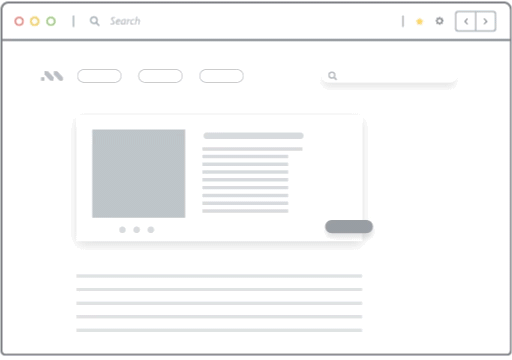
Assigning a mentor/buddy
Starting a new job can feel overwhelming, and employees who lack early support may struggle to integrate smoothly. Assigning an onboarding buddy helps new hires feel more comfortable and increases engagement.
Benefits of a assigning a mentor for new hires:
- Provides guidance and answers questions about company processes.
- Encourages social integration by fostering informal relationships.
- Reduces stress and uncertainty by offering real-time support.
- Boosts confidence and engagement as employees feel supported in their transition.
Setting clear goals and expectations
Employees perform best when they have clarity on what’s expected of them. Setting SMART (Specific, Measurable, Achievable, Relevant, Time-bound) goals ensures that new hires understand their objectives and how success is measured.
Here’s how to set effective goals:
- Define short-term & long-term goals aligned with company objectives.
- Discuss key performance indicators to track progress.
- Conduct goal-setting sessions with managers to ensure alignment.
- Provide a roadmap for success to help employees stay focused.
Encouraging social integration
A sense of belonging and connection plays a crucial role in employee engagement. If new hires feel disconnected, they are more likely to leave within the first year. HR teams should foster team-building and social interactions to help employees integrate.
Ways to encourage social integration:
- Plan team lunches, virtual coffee chats, or happy hours to create informal bonding opportunities.
- Encourage participation in company events and Employee Resource Groups (ERGs).
- Promote cross-functional collaboration to help employees interact with different teams.
- Create dedicated onboarding Slack channels or community spaces for easy interaction.
Regular check-ins and continuous feedback
Onboarding doesn’t stop after the first few weeks. HR teams and managers should schedule frequent check-ins to track progress, address concerns, and ensure employees are settling in well.
Here’s how to implement effective check-ins:
- Weekly check-ins during the first month to provide support and answer questions.
- 30-60-90 day performance reviews to assess progress and offer feedback.
- Anonymous surveys to collect honest feedback on the onboarding experience.
- Two-way feedback sessions where employees can voice concerns and suggestions.
Ongoing development and career growth
Employees who see a clear career path are more likely to stay and grow within the company. Onboarding must extend beyond initial training and focus on long-term learning and employee development.
Key areas of ongoing development include:
- Offering mentorship programs to support career progression.
- Encouraging participation in training courses, workshops, and certifications.
- Providing leadership and skill development opportunities.
- Allowing employees to take on cross-functional projects to expand their expertise.
Long term engagement and retention strategy
The final stage of onboarding is ensuring that new hires stay engaged and committed to the company long after their first few months. Companies that prioritize long-term employee engagement enjoy higher retention rates and stronger workplace culture.
Best practices for long-term engagement:
- Recognize and reward employee achievements to boost morale.
- Encourage internal career mobility by offering promotions and new roles.
- Foster a culture of continuous learning and innovation.
- Conduct stay interviews to understand what keeps employees engaged
Employee Onboarding Template Pack
Set your new hires up for success with a structured and engaging onboarding experience that boosts retention and productivity.
Download our free employee onboarding template pack, which includes an Employee Onboarding Template, Employee Onboarding Checklist, Onboarding Buddy Checklist, and an Employee Orientation Checklist.
5 Best Practices for Effective Onboarding
Here are some advanced tips to help you design and implement an effective employee onboarding program.
- Keep scaling in mind: Onboarding processes must be designed for scalability, ensuring that as your company grows, new hires continue to receive a consistent and engaging experience. Standardized training materials, automated workflows, and structured mentorship programs help maintain onboarding quality regardless of hiring volume.
- Communicate at every step: Clear and continuous communication is essential to help new hires feel informed and supported. From preboarding to ongoing development, providing regular check-ins, feedback loops, and transparent expectations ensures employees stay engaged and aligned with company goals.
- Create a list of FAQs: New hires often have similar questions about company policies, benefits, tools, and workflows. A well-structured FAQ resource helps employees find answers quickly, reducing confusion and the workload on HR teams. FAQs can be included in an onboarding portal, employee handbook, or digital adoption platform for easy access.
- Re-onboard when necessary: Onboarding isn’t just for new hires. Employees moving to new roles, teams, or returning from extended leave may require a refresher to adapt to updated processes and expectations. Re-onboarding ensures smooth transitions, helping employees regain productivity faster.
- Leverage technology: Using digital adoption platforms (DAPs), AI-driven learning tools, and automated onboarding workflows enhances the onboarding experience. Platforms like Whatfix provide interactive, in-app guidance, self-guided walkthroughs, and real-time support, allowing employees to learn in the flow of work while reducing HR and manager overhead.
Benefits of an Effective New Employee Onboarding Process
Here are some of the most significant benefits of implementing an employee onboarding process for your organization.
- Enhances employee experience and engagement: A structured onboarding process ensures that new hires feel welcomed, supported, and engaged from the start. When employees receive clear expectations, training, and mentorship, they integrate faster into the company culture, leading to higher motivation and job satisfaction.
- Increases productivity by accelerating the learning curve: New hires take time to reach full productivity, but a well-designed onboarding process shortens this transition. Studies indicate that 77% of employees who go through a structured onboarding program achieve their performance goals faster. By combining hands-on training, digital tools, and mentorship, organizations can help employees become confident and effective in their roles more quickly.
- Improves job satisfaction and retention: A strong onboarding process helps new hires feel confident, supported, and aligned with company goals, which directly impacts their job satisfaction. When employees receive structured guidance, mentorship, and career development opportunities, they are more likely to stay engaged and committed to the organization. By ensuring a smooth transition into their roles, companies can reduce early employee turnover and build a loyal, high-performing workforce.
- Helps attract top talent: A company’s onboarding process plays a critical role in employer branding and talent acquisition. In fact, 60% of candidates consider a company’s onboarding process when deciding to accept a job offer. A seamless, engaging onboarding experience not only ensures a smooth transition for new hires but also enhances the company’s reputation, making it more attractive to high-caliber candidates.
5 Best Software Tools for Onboarding New Employees
Organizations implement employee onboarding software to facilitate smooth and simple employee onboarding for new hires. These software platforms provide a full introduction to a company’s product, structure, internal policies, values, and more. Here are some popular employee onboarding software providers:
1. Whatfix
Whatfix is a digital adoption platform (DAP) that transforms the employee onboarding experience by providing in-app, real-time guidance and self-service support. Whatfix integrates directly into enterprise applications to deliver interactive, step-by-step walkthroughs, tooltips, and knowledge resources, ensuring new hires learn by doing. This significantly reduces onboarding time, increases knowledge retention, and empowers employees to become productive faster. With Whatfix’s personalized and role-based onboarding, companies can tailor the experience for each new hire, ensuring they receive relevant training based on their role, department, or location.
Highlights:
- Interactive, in-app walkthroughs that provide real-time, on-the-job training
- Personalized role-based onboarding for customized learning paths
- Self-help widgets that allow employees to find answers instantly without disrupting workflow
- Seamless integration with HR software
- Advanced analytics to track onboarding progress and measure effectiveness
2. Bamboo HR
Bamboo HR is widely popular for being a self-onboarding solution. It relieves the HR teams of the majority of repetitive tasks and allows them to spend more time getting to know the new hire and introducing them to the overall culture and practices of the company. Bamboo’s overall user experience makes it easy for the HR team to track progress and focus on the bigger picture of the onboarding process.
Highlights:
- Electronic signature software to complete paperwork for new hires quickly
- Custom workflows
- Open API
- 7-day free trial
3. Workday
Workday is a cloud-based HCM software that streamlines the employee onboarding process through automation and intuitive workflows. It enables HR teams to manage compliance, track onboarding progress, and provide self-service options for new hires, ensuring a smooth transition into the company. Workday integrates seamlessly with payroll, benefits, and LMS, making it a comprehensive solution for enterprise-level organizations.
Highlights:
- Personalized onboarding dashboards for new hires
- AI-driven automation for workflow management
- Mobile-friendly experience for seamless remote onboarding
- Integration with HR, payroll, and learning management systems
4. Rippling
Rippling offers an all-in-one platform that combines HR, IT, and payroll management to simplify the onboarding experience. It automates employee provisioning, ensuring that new hires receive access to the right tools, software, and permissions from day one. With Rippling, HR teams can automate paperwork, assign training courses, and track onboarding progress all in one place.
Highlights:
- Automatic setup of company devices, software, and payroll
- Custom onboarding checklists and workflows
- Role-based access control for IT security and compliance
- Seamless integration with over 500 third-party apps
5. SAP SuccessFactors
SAP SuccessFactors is a robust, enterprise-grade onboarding solution that enhances the new hire experience while aligning with long-term workforce planning. It provides interactive onboarding portals, AI-driven insights, and integration with learning and performance management tools to ensure continuous employee development. SuccessFactors also facilitates social collaboration and mentorship programs for new hires to integrate seamlessly into the company culture.
Highlights:
- AI-powered onboarding journey with automated workflows
- Learning and development integration for continuous training
- Onboarding analytics and real-time tracking
- Built-in compliance management for global organizations
FAQs
Why does onboarding matter?
Onboarding is crucial for ensuring new hires feel welcomed, supported, and prepared to succeed in their roles. A strong onboarding process improves employee engagement, productivity, and retention, reducing early turnover and enhancing overall company culture.
How often should you update your onboarding process?
HR teams should continuously assess and refine their onboarding process based on employee feedback, technological advancements, and business needs. Reviewing it at least once a year ensures relevance, efficiency, and alignment with company goals.
How long should employee onboarding take?
While many companies limit onboarding to a few weeks, the most effective programs extend for 90 days to a full year. A longer, structured onboarding process ensures better knowledge retention, engagement, and smoother integration into company culture.
What are the biggest onboarding mistakes HR teams make?
Common mistakes include lack of structure, overwhelming paperwork, unclear job expectations, minimal engagement with managers, and neglecting cultural integration. Poor onboarding leads to lower retention and slower productivity ramp-up.
What’s the best way to onboard remote employees?
A strong remote onboarding process includes clear communication, interactive digital onboarding tools, virtual meet-and-greets, and role-specific training. Using digital adoption platforms (DAPs) like Whatfix ensures remote employees receive real-time guidance and self-service support within their workflows.
How can AI and automation improve employee onboarding?
AI and automation streamline onboarding by personalizing training, automating repetitive tasks, and providing real-time support. AI-driven chatbots, automated workflows, and in-app guidance tools like Whatfix enhance new hire engagement, learning retention, and productivity.
Onboarding Clicks Better with Whatfix
With Whatfix Digital Adoption Platform, organizations can transform their onboarding process into an interactive, personalized, and automated experience. Whatfix provides in-app guidance, self-help resources, and real-time support directly within enterprise applications, ensuring employees learn by doing. By reducing manual training efforts, accelerating knowledge retention, and improving overall onboarding efficiency, Whatfix empowers HR teams to create a structured, scalable, and engaging onboarding journey that drives higher retention, productivity, and employee satisfaction.
Upgrade your onboarding experience with Whatfix and help your new hires become confident, engaged, and productive—faster. Schedule a free demo with us today!
